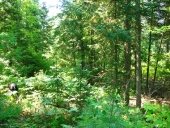





 2
2









 1
1




Changing one thing, no matter how tiny, is still change
 1
1




Best luck: satisfaction
Greatest curse, greed

 1
1




As a first time poster we suggest you fill out your profile which will list certain things with your name when you post such as your location weather and soil type which makes it easier to make sure we are giving appropriate advice for your conditions. Go to profile at the top of the page or click on your name will take you to your profile page but selecting "profile wil alow you to edit it. You can also send a message to one individual by clicking on their name and select the PM button in their profile.knut inge wrote:Hi all, first poster here.
knut inge wrote:
I have a challenge in that I am working with mostly bare bedrock (some scots pine, some norway spruce), acidic soil. I would like to be able to plant diverse bushes and trees, but the property is not accessible by car - everything must be carried by boat and hand. I.e. getting 10 tonnes of compost soil is out of the question.
knut inge wrote:
One issue is that rainfall tends to accumulate in pits after rainfall and in winter (root rot), while in summer drying out is a real problem.
knut inge wrote:
We do have plenty of scots pine. My question is if I could/should use excess pine logs, branches and needles along with household food waste in hugel mounds with a thin layer of semi composed pine needles/soil on top. Would that stabilize moisture (if placed on a sloping piece of rock)? Would it turn into good soil and a nice spot to grow?
Blackberries are a good pioneer species. Grapes when thriving can supply a lot of biomass when pruned properly. Long vines in summer need to be cut back to encourage fruiting buds and when fruiting begins to put sugar into the fruit instead of growth. I use a hedge trimmer on mine cutting just outside the level of fruit. As the time line progresses observe micro climates where strawberries and figs will thrive.knut inge wrote:
My hope is to be able to plant hardy figs and grapes, apricot, blackberry and strawberry. I do realize that this is going to be a multi-year project.
knut inge wrote:
Would it make sense to introduce myko, as there is very little broad-leaves trees in the area due to sheep grazing.
knut inge wrote:
Thanks for any response
Knut
Hans Albert Quistorff, LMT projects on permies Hans Massage Qberry Farm magnet therapy gmail hquistorff




Invasive plants are Earth's way of insisting we notice her medicines. Stephen Herrod Buhner
Everyone learns what works by learning what doesn't work. Stephen Herrod Buhner
 1
1




 Hugelkultur with pine will be acidic ... so the berries will be fine there. Think of Paul's favourite: huckleberry! And blueberries, blackberries, raspberries, etc.
Hugelkultur with pine will be acidic ... so the berries will be fine there. Think of Paul's favourite: huckleberry! And blueberries, blackberries, raspberries, etc.
"Also, just as you want men to do to you, do the same way to them" (Luke 6:31)




homestead houligan: one who lives on any homestead and tends to break the "rules" or practices of a traditional homestead. ex:using practices such as permaculture on a homestead. homesteadhouligan.com








homestead houligan: one who lives on any homestead and tends to break the "rules" or practices of a traditional homestead. ex:using practices such as permaculture on a homestead. homesteadhouligan.com









Best luck: satisfaction
Greatest curse, greed




Thekla McDaniels wrote:Hi Knut,
I don't know if pines have an anti rot factor, or just a "slow" rot rate, either way, that may be to your advantage, because when it does rain, you will not lose "everything". I'm thinking it would help provide a slow and consistent source of "nutrients". And a fast rot might overheat the pile and kill all the roots in the mound.
Have you held back from adding seaweed, or is the supply limited? I think you could safely use huge amounts.
it is an interesting project. The place sounds beautiful. I might want to come visit.

I think the wind might be important to consider. How strong is it and how constant? Can you shelter from the wind in any way? both for your self and for your plants?











Hans Albert Quistorff, LMT projects on permies Hans Massage Qberry Farm magnet therapy gmail hquistorff




"What is worth knowing, is difficult to learn"








 1
1




if you can get sea buckthorn (seaberry) and goumi berry plants, they're nitrogen fixers, the berries are very nutritious and they're drought / salt tolerant. they laugh at wind a harsh conditions. they grow in a very wide soil ph also. the thorns on the seaberry would deter some grazing but goats would probably still try it as they'll eat anything. bet they would grow very well on your hugels once established. honeyberries and blueberries like acidic soil also. could use the goumi and seaberry on the windy side as a windbreak for less wind tolerant species. good luck!knut inge wrote:I wonder how well mulberry would do in this setting.
I hardly know of anyone planting mulberry in my area, but I am reading that they tend to be wind tolerant (some species being used for wind break), tolerating salt spray, and tolerant for different soil types.
M. Nigra being preferred for consumption, while Illinois everbearing (hybrid) preferred for robustness.
-k




Best luck: satisfaction
Greatest curse, greed












"What is worth knowing, is difficult to learn"





|
I claim this furniture in the name of The Ottoman Empire! You can keep this tiny ad:
Freaky Cheap Heat - 2 hour movie - HD streaming
https://permies.com/wiki/238453/Freaky-Cheap-Heat-hour-movie
|





